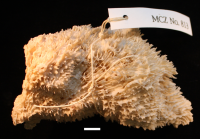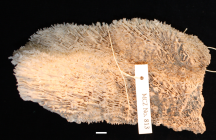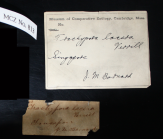WoRMS taxon details
Oxypora Saville Kent, 1871
205536 (urn:lsid:marinespecies.org:taxname:205536)
accepted
Genus
Trachypora lacera Verrill, 1864 accepted as Oxypora lacera (Verrill, 1864) (type by subsequent designation)
Trachypora Verrill, 1864 · unaccepted > junior homonym
- Species Oxypora convoluta Veron, 2000
- Species Oxypora crassispinosa Nemenzo, 1979
- Species Oxypora echinata (Saville Kent, 1871)
- Species Oxypora egyptensis Veron, 2000
- Species Oxypora lacera (Verrill, 1864)
- Species Oxypora aspera (Ellis & Solander, 1768) accepted as Echinophyllia aspera (Ellis & Solander, 1786) (unaccepted > superseded combination)
- Species Oxypora contorta Quelch, 1886 accepted as Oxypora lacera (Verrill, 1864) (unaccepted > junior subjective synonym)
- Species Oxypora glabra Nemenzo, 1959 accepted as Echinophyllia glabra (Nemenzo, 1959) (unaccepted > superseded combination, basionym)
- Species Oxypora titizimaensis Yabe, Sugiyama & Eguchi, 1936 accepted as Oxypora lacera (Verrill, 1864) (unaccepted > junior subjective synonym)
marine, fresh, terrestrial
Saville Kent W. (1871). On some new and little-known species of madrepores, or stony corals, in the British Museum Collection. <em>Proceedings of the Scientific Meetings of the Zoological Society of London for the Year 1871.</em> 275-286, pls. 23-25. [details]
Description 'This name is proposed in place of Trachypora of A. E. Verrill (Bulletin Mus. Comp. Zoology, Cambridge, U. S. p. 53, 1863),...
Description Colonies are primarily foliaceous, usually with very thin folia. Calices are round or oval in shape, irregular, shallow,...
Description 'This name is proposed in place of Trachypora of A. E. Verrill (Bulletin Mus. Comp. Zoology, Cambridge, U. S. p. 53, 1863), which has been already adopted by Milne-Edwards for a genus of the Cyathophylliidæ. He separates it from Echinopora on account of the echinate and coarsely costate character of the lower surface of the corallum.' (Saville Kent, 1871: 283–284) [details]
Description Colonies are primarily foliaceous, usually with very thin folia. Calices are round or oval in shape, irregular, shallow,...
Description Colonies are primarily foliaceous, usually with very thin folia. Calices are round or oval in shape, irregular, shallow, not strongly inclined on the corallum surface. Septa are few, columellae are poorly developed. The coenosteum is pitted at the insertion of new septo-costae. Polyps are extended only at night. (Veron, 1986 <57>) [details]
Hoeksema, B. W.; Cairns, S. (2024). World List of Scleractinia. Oxypora Saville Kent, 1871. Accessed through: World Register of Marine Species at: https://www.marinespecies.org/aphia.php?p=taxdetails&id=205536 on 2024-04-19
Date
action
by
![]() The webpage text is licensed under a Creative Commons Attribution 4.0 License
The webpage text is licensed under a Creative Commons Attribution 4.0 License
original description
Saville Kent W. (1871). On some new and little-known species of madrepores, or stony corals, in the British Museum Collection. <em>Proceedings of the Scientific Meetings of the Zoological Society of London for the Year 1871.</em> 275-286, pls. 23-25. [details]
original description (of Trachypora Verrill, 1864) Verrill, A. E. (1864). List of the polyps and corals sent by the Museum of Comparative Zoology to other institutions in exchange, with annotations. <em>Bulletin of the Museum of Comparative Zoology.</em> 1: 29-60., available online at https://www.biodiversitylibrary.org/page/6587563 [details]
context source (Hexacorallia) Fautin, Daphne G. (2013). Hexacorallians of the World. (look up in IMIS) [details]
basis of record Veron JEN. (1986). Corals of Australia and the Indo-Pacific. <em>Angus & Robertson Publishers.</em> [details]
additional source Veron JEN, Pichon M. (1980). Scleractinia of Eastern Australia – Part III. Family Agariciidae, Siderastreidae, Fungiidae, Oculinidae, Merulinidae, Mussidae, Pectinidae, Caryophyllidae, Dendrophylliidae. <em>Australian Institute of Marine Science Monograph Series.</em> 4: 1-459. [details]
additional source Veron JEN. (2000). Corals of the World. Vol. 1–3. <em>Australian Institute of Marine Science and CRR, Queensland, Australia.</em> [details]
additional source Arrigoni R, Terraneo TI, Galli P, Benzoni F (2014) Lobophylliidae (Cnidaria, Scleractinia) reshuffled: Pervasive . non-monophyly at genus level. Molecular Phylogenetics and Evolution 73: 60-64. [details]
additional source Arrigoni R, Berumen ML, Chen CA, Terraneo TI, Baird AH, Payri C, Benzoni F. (2016). Species delimitation in the reef coral genera Echinophyllia and Oxypora (Scleractinia, Lobophylliidae) with a description of two new species. <em>Molecular Phylogenetics and Evolution.</em> 105: 146-159., available online at https://doi.org/10.1016/j.ympev.2016.08.023 [details]
additional source Huang D, Arrigoni R, Benzoni F, Fukami H, Knowlton N, Smith ND, Stolarski J, Chou LM, Budd AF. (2016). Taxonomic classification of the reef coral family Lobophylliidae (Cnidaria: Anthozoa: Scleractinia). <em>Zoological Journal of the Linnean Society.</em> 178(3): 436-481., available online at https://doi.org/10.1111/zoj.12391 [details]
additional source Whitelegge, T. (1898). The Madroporaria of Funafuti. <em>The Australian Museum Memoir.</em> 3(6): 349-368.
page(s): 355 [details]
additional source Dunn, D. F. (1982). Cnidaria. McGraw-Hill Book Company. New York and other cities., volume 1, pp. 669-706
page(s): 702 [details]
redescription Arrigoni, R.; Berumen, M. L.; Stolarski, J.; Terraneo, T. I.; Benzoni, F. (2019). Uncovering hidden coral diversity: a new cryptic lobophylliid scleractinian from the Indian Ocean. <em>Cladistics.</em> 35 (3): 301–328., available online at https://doi.org/10.1111/cla.12346 [details]
original description (of Trachypora Verrill, 1864) Verrill, A. E. (1864). List of the polyps and corals sent by the Museum of Comparative Zoology to other institutions in exchange, with annotations. <em>Bulletin of the Museum of Comparative Zoology.</em> 1: 29-60., available online at https://www.biodiversitylibrary.org/page/6587563 [details]
context source (Hexacorallia) Fautin, Daphne G. (2013). Hexacorallians of the World. (look up in IMIS) [details]
basis of record Veron JEN. (1986). Corals of Australia and the Indo-Pacific. <em>Angus & Robertson Publishers.</em> [details]
additional source Veron JEN, Pichon M. (1980). Scleractinia of Eastern Australia – Part III. Family Agariciidae, Siderastreidae, Fungiidae, Oculinidae, Merulinidae, Mussidae, Pectinidae, Caryophyllidae, Dendrophylliidae. <em>Australian Institute of Marine Science Monograph Series.</em> 4: 1-459. [details]
additional source Veron JEN. (2000). Corals of the World. Vol. 1–3. <em>Australian Institute of Marine Science and CRR, Queensland, Australia.</em> [details]
additional source Arrigoni R, Terraneo TI, Galli P, Benzoni F (2014) Lobophylliidae (Cnidaria, Scleractinia) reshuffled: Pervasive . non-monophyly at genus level. Molecular Phylogenetics and Evolution 73: 60-64. [details]
additional source Arrigoni R, Berumen ML, Chen CA, Terraneo TI, Baird AH, Payri C, Benzoni F. (2016). Species delimitation in the reef coral genera Echinophyllia and Oxypora (Scleractinia, Lobophylliidae) with a description of two new species. <em>Molecular Phylogenetics and Evolution.</em> 105: 146-159., available online at https://doi.org/10.1016/j.ympev.2016.08.023 [details]
additional source Huang D, Arrigoni R, Benzoni F, Fukami H, Knowlton N, Smith ND, Stolarski J, Chou LM, Budd AF. (2016). Taxonomic classification of the reef coral family Lobophylliidae (Cnidaria: Anthozoa: Scleractinia). <em>Zoological Journal of the Linnean Society.</em> 178(3): 436-481., available online at https://doi.org/10.1111/zoj.12391 [details]
additional source Whitelegge, T. (1898). The Madroporaria of Funafuti. <em>The Australian Museum Memoir.</em> 3(6): 349-368.
page(s): 355 [details]
additional source Dunn, D. F. (1982). Cnidaria. McGraw-Hill Book Company. New York and other cities., volume 1, pp. 669-706
page(s): 702 [details]
redescription Arrigoni, R.; Berumen, M. L.; Stolarski, J.; Terraneo, T. I.; Benzoni, F. (2019). Uncovering hidden coral diversity: a new cryptic lobophylliid scleractinian from the Indian Ocean. <em>Cladistics.</em> 35 (3): 301–328., available online at https://doi.org/10.1111/cla.12346 [details]
 Present
Present  Inaccurate
Inaccurate  Introduced: alien
Introduced: alien  Containing type locality
Containing type locality
From editor or global species database
Biology zooxanthellate [details]Comparison There are no unambiguous apomorphies for Oxypora, although compact columellae (1–3 threads) and the absence of distinct paliform (uniaxial) lobes are synapomorphies on the morphological phylogeny. The three representatives analysed here are nested within the clade dominated by Echinophyllia (subclade F + G sensu Arrigoni et al., 2014c), as a polyphyletic group on the molecular tree, and as a monophyly on the morphological tree. Together with Echinomorpha, these genera form a well-supported clade with a bootstrap value of 71 and decay index of 4, and are defined by four synapomorphies: (1) organically united corallites (likelihood of 0.86 based on the Mk1 model); (2) extensive coenosteum (≥ corallite diameter) (likelihood 0.75); (3) columellae ≥ 1/4 of calice width (likelihood 0.92); and (4) loss of epitheca (likelihood 0.84). Historically, the affiliation between Oxypora and Echinophyllia has been extremely close. The latter was synonymised under the former by Crossland (1952), who found no morphological traits to separate the two genera. Chevalier (1975) also placed Oxypora glabra Nemenzo, 1959: 122, under Echinophyllia based on a specimen from New Caledonia. This resulted in Oxypora lacera (Verrill, 1864: 53) being the sole species classed in Oxypora during that time. Interestingly, the position of Oxypora glabra on the molecular phylogeny does show that Oxypora glabra is more closely related to all Echinophyllia species except E. echinata, which forms a clade with Oxypora lacera and O. convoluta Veron, 2000, vol. 2: 340. The close relationship between Echinophyllia and Oxypora is further supported by the presence of alveoli, which are small pits on the exotheca forming at points of insertion of new septocostae (Chevalier, 1975; Wood, 1983; Veron, 1986; Veron, 2000; Benzoni, 2013). As explained above for Echinophyllia, the unexpected split of this group into the molecular clades F and G, not accompanied by consistent morphological variation, indicates that the Echinophyllia-Oxypora dichotomy ought to be tested with more comprehensive taxonomic and genetic sampling of Oxypora. [details]
Description 'This name is proposed in place of Trachypora of A. E. Verrill (Bulletin Mus. Comp. Zoology, Cambridge, U. S. p. 53, 1863), which has been already adopted by Milne-Edwards for a genus of the Cyathophylliidæ. He separates it from Echinopora on account of the echinate and coarsely costate character of the lower surface of the corallum.' (Saville Kent, 1871: 283–284) [details]
Diagnosis Colonial; laminar. Budding intracalicular. Corallites may be polymorphic; organically united and lacking distinct calical walls. Monticules absent. Coenosteum spinose; extensive amount (≥ corallite diameter). Calice width medium (4–15 mm), with low relief (< 3 mm). Costosepta mostly confluent. Septa in < three cycles (< 24 septa). Free septa irregular. Septa spaced < 6 septa per 5 mm. Costosepta unequal in relative thickness. Columellae trabecular and compact (1–3 threads), ≥ 1/4 of calice width, and discontinuous among adjacent corallites with lamellar linkage. Internal lobes absent. Epitheca absent. Endotheca low-moderate (tabular). Tooth base at midcalice elliptical-parallel. Tooth tip forming multiaxial bulb. Tooth height medium (0.3–0.6 mm). Tooth spacing medium (0.3–1.0 mm), with ≤ six teeth per septum. Tooth size equal between wall and septum. Granules scattered on septal face; weak (rounded). Interarea smooth. Walls formed by dominant paratheca and partial septotheca. Thickening deposits with extensive stereome. Costa centre clusters weak; > 0.6 mm between clusters; medial lines strong. Septum centre clusters weak; 0.3–0.5 mm between clusters; medial lines weak. [details]
Remark Oxypora was established by Saville Kent (1871: 283) to replace Trachypora Verrill, 1864: 53, which was represented by Trachypora lacera Verrill, 1864: 53, but had already been used by Milne Edwards and Haime (1851a, vol. 5: 158) for a Devonian tabulate coral (Wells, 1936). Saville Kent's proposal was probably unknown to Klunzinger (1879), who placed Trachypora lacera in Echinophyllia Klunzinger, 1879: 69 (Quelch, 1886). Partly as a result of this affiliation, Oxypora was grouped by Wells (1935) with Echinophyllia, Tridacophyllia de Blainville, 1830: 327 (= Pectinia de Blainville, 1825: 201), Mycedium, and Physophyllia Duncan, 1884: 118, in Tridacophylliidae Thiel, 1932: 96, which was originally placed in Fungida (see Yabe and Eguchi, 1935b). Trachypora lacera was later designated as the type of Oxypora by Wells (1936), validating it as a separate genus from Echinophyllia. Oxypora was placed in the newly-established Pectiniidae by Vaughan and Wells (1943: 196), along with the five Tridacophylliidae genera above. Until relatively recently, this classification remained stable (e.g. Wells, 1956; Nemenzo, 1959; Chevalier, 1975; Wood, 1983; Veron, 2000). Molecular-based phylogenies have indicated that Pectinia, Mycedium and Physophyllia are in the Merulinidae clade, distinct from the sister groups comprising Echinophyllia and Oxypora (subclade F + G sensu Arrigoni et al., 2014c) that are nested within Lobophylliidae (clade XIX sensu Fukami et al., 2008; Arrigoni et al., 2014b, c, 2015, 2016a). Consequently, Pectiniidae has been synonymised (Budd et al., 2012; see also Huang et al., 2011, 2014b; Arrigoni et al., 2012). Oxypora is widely distributed on the reefs of Indo-Pacific, present from the Red Sea and East Africa to as far east as the Marshall Islands in the Northern Hemisphere and Samoa in the Southern Hemisphere (Veron, 2000). [details]
From other sources
Description Colonies are primarily foliaceous, usually with very thin folia. Calices are round or oval in shape, irregular, shallow, not strongly inclined on the corallum surface. Septa are few, columellae are poorly developed. The coenosteum is pitted at the insertion of new septo-costae. Polyps are extended only at night. (Veron, 1986 <57>) [details]
| Language | Name | |
|---|---|---|
| English | porous lettuce corallettuce coralgreen-eyed cup coral | [details] |
| Japanese | アナキッカサンゴ属 | [details] |


